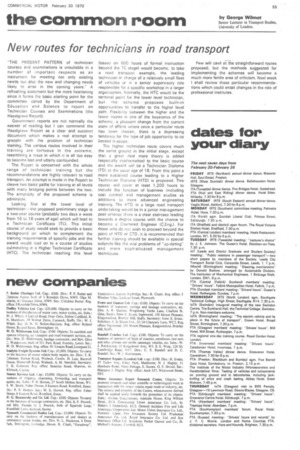New routes for technicians in road transport
Page 57

If you've noticed an error in this article please click here to report it so we can fix it.
-THE PRESENT PATTERN of technician courses and examinations is unsuitable in a number of important respects as an instrument for meeting not only existing needs but also the new and changing needs likely to arise in the coming years." A refreshing statement but the more heartening since it forms the basic starting point for the committee called by the Department of Education and Science to report on Technician Courses and Examinations (the Hazelgrave Report).
Government reports are not normally the easiest of reading but I can commend the Haze'crave Report as a clear and succinct document which makes a real attempt to grapple with the problem of technician training. The various routes involved in their training are tortuous in the extreme, resembling a maze in which it is all too easy to become lost and utterly confounded.
The Report is concerned with the whole range of technician training but the recommendations are highly relevant to road transport. An attempt is made in the Report to cleave two basic paths for training at all levels with many bridging points between the two. The simplicity of the proposed scheme is admirable.
Looking first at the lower level of technician the proposed preliminary stage is a two-year course (probably two days a week from 16 to 18 years of age) which will lead to a Technician Certificate (IC). This initial course of study would seek to provide a basic background on which to complement the training requirements of specific jobs and the award would lead on to a course of studies culminating in a Higher Technician Certificate (HTC). The technician reaching this level
(based on 600 hours of formal instruction beyond the IC stage) would become, to take a road transport example, the leading technician in charge of a relatively small fleet of vehicles or in a senior supervisory role responsible for a specific workshop in a larger organization. Normally, the HTC would be the terminal point for the lower level technician, but the scheme proposes built-in opportunities to transfer to the higher level path. Flexiblity between the higher and the lower routes is one of the keystones of the scheme, a pleasant change from the current state of affairs where once a particular route has been chosen, there is a depressing tendency for the type of job opportunity to be limited in scope.
The higher technician route covers much the same ground in the initial stage, except that a great deal more theory is added (especially mathematics) to the basic course and the award will be a Technician Diploma (TD) at the usual age of 18. From this point a more sustained course leading to a Higher Technician Diploma (HTD) is proposed. This • course will cover at least 1,200 hours to include the function of business (including cost control) and management studies as additions to more advanced engineering training. The HID in a large road transport undertaking would be in a junior management post whence there is a clear staircase leading towards a degree course with the chance to become a Chartered -Engineer (C.Eng.). For those who do not wish to proceed beyond the point of HID or CID, it is recommended that further training should be available in special subjects like the vital problems of "up-dating" and more sophisticated management techniques.
Few will cavil at the straightforward routes proposed, but the methods suggested for implementing the schemes will become a much more fertile area of criticism. Next week I shall review these particular recommendations which could entail changes in the role of professional institutes.














































































































































































































